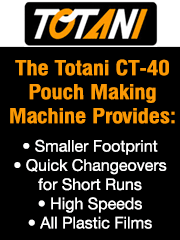The Benefits of Proper Vision Inspection
- Published: February 11, 2022
 Print inspection systems are an easy-to-use solution that can be retrofitted to any printing press, enabling operators to setup and run faster, as well as locate and analyze defects before they become critical. Systems include 100 percent print inspection, color monitoring and integrated workflow options.
Print inspection systems are an easy-to-use solution that can be retrofitted to any printing press, enabling operators to setup and run faster, as well as locate and analyze defects before they become critical. Systems include 100 percent print inspection, color monitoring and integrated workflow options.
Conor O’Neill, business development manager for Maxcess Vision Inspection, recently shared some informative thoughts on vision inspection and vision systems.
Why is proper vision inspection so important in a converting application?
O’Neill: Often the process is too fast and repetitive to depend on humans to inspect products in converting applications. If inspected during the converting process, waste can be avoided by alerting the operator to process issues. Also, automated inspection enables converters to ship defect-free product to customers and thus avoid contract penalties, product return and rework.
Is 100 percent inspection worth the investment?
O’Neill: It depends on the cost: substrate cost, the cost of returns due to quality issues and the cost of rework. Typically equipment is purchased primarily to satisfy a customer’s requirement for 100 percent inspection and the converter realizes the value and uses the ROI generated as a reason for subsequent purchases. Typical return on investment should be within a 24-month period.
What kinds of defects are vision inspection systems trying to find? What are the most critical?
O’Neill: Typically vision systems see all defects. Most users are not aware of how many defects they generate until they install their first vision system. The key to value is to then decide how to use the data to improve their process and what defects are OK to ship, if any.
How wide or narrow of webs can vision systems see?
O’Neill: Vision systems can be used on any web width. Often a single camera is not used on anything wider than 50 inches or so as it would need to be very far from the web. Inspection systems can be used to inspect threads for currency up to 30-foot paper webs.
How does one determine which vision inspection system they need?
O’Neill: The first thing is to determine the cost of returns, defects, etc., and then to understand the potential for a return. Once the potential return is determined, it’s important to build user requirements and then look at which vendor can meet those requirements.
What types of applications can vision systems be used in?
O’Neill: Vision systems can be used for quality control, key feature measurements on processes and also to automate processes that operators find difficult. Vision systems can inspect printed products, coatings, adhesives and converting issues such as seams, perforations and more.
What’s unique about Maxcess Vision Systems?
O’Neill: Our vision systems are built using open system standards improving asset lifecyle and optimizing your investment. Optimized for the process, our systems guarantee that your investment is applied 100 percent. You don’t pay for features that are not required. Plus, our systems are reliable and easy to use. Maxcess’s advantage is that it supplies a wide variety of solutions and can most likely meet your requirements.
What does the future of vision inspection technologies look like?
O’Neill: Vision systems will continue to get smarter, in particular with new technologies like deep learning. They will be used to allow operators to improve productivity by dropping operator-to-line ratios.
Vision systems will become more automated and less obvious, as they will be built into the equipment and will become inherent in the operation of that equipment as opposed to being an add on.













